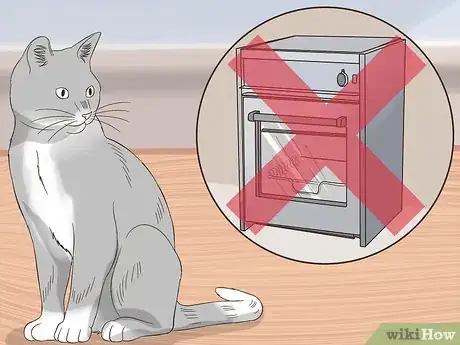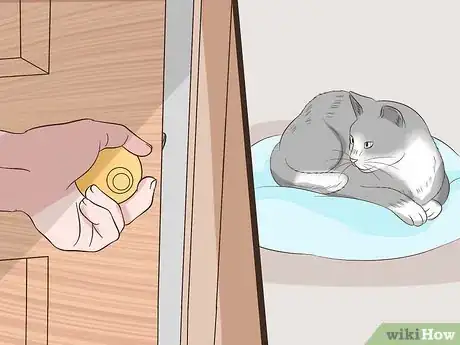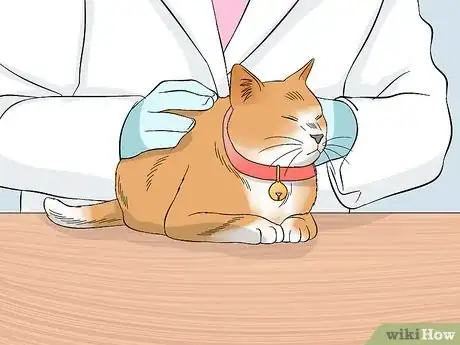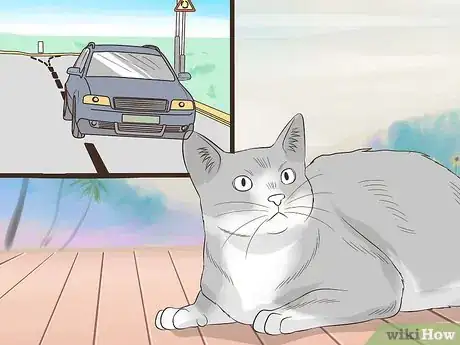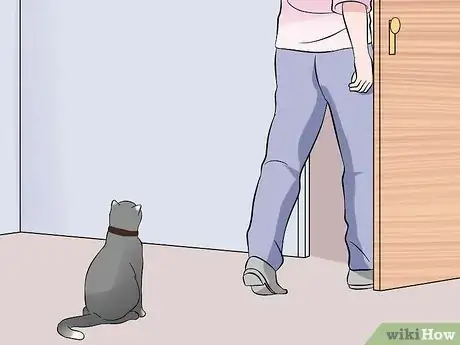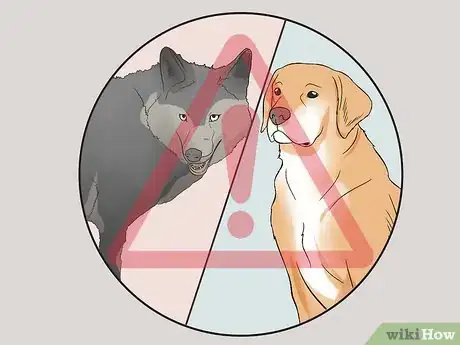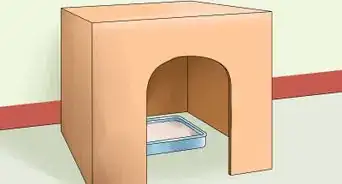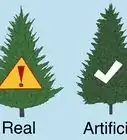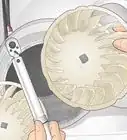This article was co-authored by Pippa Elliott, MRCVS. Dr. Elliott, BVMS, MRCVS is a veterinarian with over 30 years of experience in veterinary surgery and companion animal practice. She graduated from the University of Glasgow in 1987 with a degree in veterinary medicine and surgery. She has worked at the same animal clinic in her hometown for over 20 years.
There are 18 references cited in this article, which can be found at the bottom of the page.
This article has been viewed 15,847 times.
Cats are great pets. They are wonderful companions for many people. However, they need to be kept safe from a number of potential dangers. Keep your cat safe in your house, outdoors, and from predators, plants, and poisons. Guarantee your cat will life a long and happy life with you.
Steps
Staying Safe at Home
-
1Secure anything that could harm your cat. Make sure nothing can fall on your cat and injure it.
- Fasten any heavy objects that are placed up high. You don’t want anything heavy to fall on your cat when it’s exploring.
- Place cords out of reach of your cat. Cats will play with anything dangling and could harm themselves. Spray cords with pepper in order to keep cats away from them. [1]
- Close your toilet seat or any other open water sources. Cats can easily drown in open water.
- Keep your cat away from anything particularly hot. They can harm themselves on irons that are left out or on a warm oven. [2]
- Block off any areas that cats may explore and get stuck. Behind refrigerators and cabinets may be especially dangerous. [3]
-
2Keep cats away from things they could ingest. Your cat could choke on objects, eat foods that can harm it, or swallow dangerous chemicals. [4]
- Secure anything that cats could choke on. Don’t leave any small objects out where cats can reach them.
- Put away any food. Cats may eat anything that’s left out. Make sure to especially put away any foods that are dangerous to cats, such as chocolate, onions, or medicine.
- Keep away dangerous chemicals. Fasten all cabinets that have chemicals that cats may be drawn to. Antifreeze is especially tempting to cats. [5]
Advertisement -
3Make sure your cat stays indoors. The outdoors presents another set of dangers for your cat. Secure your cat indoors so it won’t encounter these dangers or potentially run away.
- Keep all doors closed and locked. Cats can easily slip out of a partially open door.
- Make sure all windows have screens and are closed when you’re not around. Cats can easily fall out of windows. They don't always land on their feet. [6]
- If you decide to have your cat outdoors, make sure you are around when they go outside. It’s harder to control the outdoor environment.
Keeping Your Cat Safe Outside
-
1Get them a collar. A good collar can help your cat be safer outdoors, stay away from accidents, and make them easier to find if they get lost.
- Make sure their collar breaks away so they can’t choke themselves. Collars can get caught on something, so make sure the collar will not strangle the cat.
- Have a bell on the collar. This will help you keep track of the cat and know where they are at all times.
- Keep your contact information on the cat’s collar. Have your phone number on the cat’s collar so if it runs away, someone will be able to call you.
- If you don’t want to use a collar, consider microchipping your cat. It’s no more painful than a vaccination and can make sure anyone who finds your cat can contact you. [7]
-
2Keep cats away from outdoor dangers, such as cars or other hazards. Cats are curious and can run into danger when being outside. Make sure they are in a secure area so they don’t run into the street.
- Have your cats secure when they are outside. Wire mesh fences with a high angle can keep them penned in. Make sure your cat cannot get out to the roadway or out of your yard. [8]
- Keep your cat away from the road. They may be attracted to the sound of cars, but can be severely injured or killed by vehicles. [9]
- Have a cat door. Cats can easily run back inside and escape from predators or other dangers by using a cat door.
- Use a leash. Cats don’t like leashes, but a leash can guarantee your cat won’t get into any dangerous situations.
-
3Protect your cat from the weather. If your cat is mostly an outdoors cat, you need to protect it from severe weather. Make sure your cat stays cool during a heatwave and is sheltered during bad weather.
- Let your cat have places to cool off if it’s hot. Find shady areas outdoors for your cat to sit and rest.
- Give your cat ice cubes or cool water. They can help to cool the cat down.
- Notice the signs of heatstroke, including panting, vomiting, and fever. Make sure your cat is safe even if it’s hot outside. [10]
- Cats usually don’t like rain or thunderstorms. If possible, bring your cat indoors. If not, make sure it is under a dry shelter. [11]
-
4Travel safely with your cat. Traveling with a cat can be difficult. Make sure you have a good carrier to keep your cat safe and secure.
- Secure your carrier in the car. In the case of sudden stoppage or an accident, your cat will continue to be safe.
- Unlike dogs, cats do not like car rides. Stay calm and stress free during car rides to make you’re your cat does not have any undue stress. [12]
- Stop every two hours if you’re driving. Cats need to get out and stretch as well as use the restroom.
-
5Bring your cat inside when you’re away. Cats can get into dangerous situations without you around. Keep them safe by keeping them inside.
- Find a nice area for your cat to look outside. Cats like to sit by windows to observe the outdoors, even if they cannot be outdoors.
- Make sure your cat cannot get outside when you’re away. Lock any cat doors if you have them.
- Give your cat plenty of space to play indoors. Cats need to expend energy, so giving them a cat jungle may be a good way for them to burn off energy indoors.
Avoiding Predators, Plants & Poison
-
1Keep your cat safe from predators. Cats can encounter a number of predators, especially when they’re outdoors. Make sure they are safe and protected from any predators.
- Keep safe from coyotes. Your cat may encounter coyotes outdoors, since they live nearly everywhere in North America. Stay away from secluded areas with lots of brush. [13]
- Stay away from strange dogs. Dogs may want to chase cats. If you encounter any dogs outside, bring your cat indoors immediately. [14]
- Introduce your dog to your cat. Keep your cat and dog separate or in carriers at first. Slowly introduce them to each other to avoid any problems. [15]
-
2Stay away from plants. Many plants are poisonous to cats. Keep your cats away from any plants that may harm them. [16]
- Cats may chew on indoor and outdoor plants. Put indoor plants out of a cat’s reach and watch cats when they are around indoor plants. [17]
- Lilies are especially poisonous to cats. Even one lick can cause severe kidney damage. [18]
- Know the outdoor plants. Some plants are more poisonous than others to cats. If possible, get rid of any plants that are especially dangerous to cats.
-
3Avoid indoor and outdoor poisons. Cats will eat almost anything. While some things may just make a cat sick, others will kill it.
- Secure perfumes and aftershaves. Drinking ethanol and the oils in these chemicals can kill cats.
- Know that anything poisonous to humans is also poisonous to cats. Keep cleaning supplies put away as well as any other household chemicals.
- Chocolate, coffee, and tea are all especially toxic to cats. They are also attracted to its sweet scent and taste. Don’t leave out any of these so your cat won’t eat them.
References
- ↑ http://www.rockhamptonregion.qld.gov.au/Council-Services/Animal-Management/Owning-a-cat/Cat-safety-and-play-tips
- ↑ http://www.ncspca.org/resources/cathealth
- ↑ http://www.catster.com/lifestyle/5-cat-health-safety-tips-home
- ↑ http://icatcare.org/advice/household-hazards
- ↑ http://www.meowfoundation.com/wp-content/uploads/2013/03/Cat-Health-and-Safety.pdf
- ↑ http://www.bhg.com/pets/cats/cat-safety/
- ↑ https://www.petfinder.com/dogs/lost-and-found-dogs/microchip-faqs/
- ↑ http://www.peteducation.com/article.cfm?c=1+2131&aid=3415
- ↑ http://www.petmd.com/cat/emergency/accidents-injuries/e_ct_broken_bones
- ↑ https://www.petfinder.com/cats/cat-care/heat-wave-safety-cat/
- ↑ http://www.petmd.com/cat/conditions/behavioral/c_ct_thunderstorm_phobias
- ↑ http://www.livescience.com/34473-why-cats-hate-car-rides.html
- ↑ http://www.adoptapet.com/blog/keep-your-pets-safe-from-coyotes/
- ↑ http://www.adoptapet.com/blog/stop-dogs-from-play-chasing-new-cat/
- ↑ http://www.adoptapet.com/blog/6-steps-to-introduce-a-new-cat-to-your-dog/
- ↑ http://www.aspca.org/pet-care/animal-poison-control/cats-plant-list
- ↑ https://www.petfinder.com/cats/cat-problems/cats-plants/
- ↑ http://www.preventivevet.com/cats/lesser-known-pet-toxicities-lily-toxicity-in-cats
About This Article
To keep your cat safe at home, secure anything that could fall over and injure your cat. Additionally, make sure your cat doesn’t have easy access to hazards like hot stoves or ovens, open toilet bowls, or tight spaces, like the area behind the fridge. You should also put away anything dangerous that your cat might accidentally eat, such as medications or foods that are poisonous to cats like garlic or chocolate. Finally, keep your cat from getting out by closing and locking your doors and windows when you’re not around. For more tips from our Veterinary Medicine co-author, including how to keep your cat safe outside and protect them from hazardous animals and plants, keep reading!
